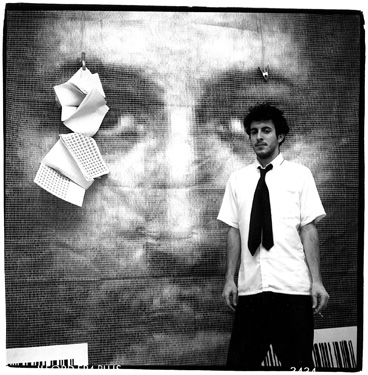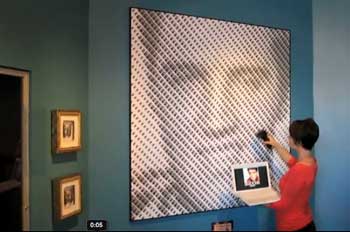Barcode Art by Scott Blake
 “I like to say that my art works,” Scott Blake giggled during our video chat interview. “Most artists seek validation from the outside, I get my validation from the beep of the barcode scanner.”
“I like to say that my art works,” Scott Blake giggled during our video chat interview. “Most artists seek validation from the outside, I get my validation from the beep of the barcode scanner.”
Often referred to as the barcode artist, Scott Blake's art revolves around this central theme. For ten years, he has been building portraits using barcodes as pixels. His barcode Elvis is on display at Ripley's Believe It or Not in San Francisco. Viewers can use their iPhones or a barcode scanner to scan individual codes which play songs and pull up album covers.
Blake's work may appear conceptually driven, but in truth the work and the artist himself are classical in nature. Conceptual art is concerned with concept alone, the finished product secondary. Blake's work is borne from inspiration; it's just happens that rather than finding inspiration in a lover's body or an azure sky, barcodes inspire Blake (and technology, and consumption and inspiration itself, among other things).
Much 'digital art' in today's market is contrivance; attractive products produced by adept technicians. Speaking to Blake, it's clear the work is no contrivance. It is a product of authentic self-expression; the artist's way of exploring his reality. We talked about the shift in the way we express ourselves as a culture. How we've come to express ourselves through clicking and typing; from text messages to Facebook and Twitter. Blake says, “I always think about Jackson Pollock throwing paint, and how expressive that was. It's just different nowadays. I don't know anyone who throws paint. Everyone nowadays types & clicks— I'm trying to talk about that world of clicking and typing; my art is a reflection of that.” He coins his work techno-expressionism.
A 2003 graduate from Savannah College of Art and Design, Blake was creating digital art before there was digital art. It was not considered a valid medium. He was among the first to recognize Photoshop as more than a tool, but an artistic medium. The progression of his work parallels the progression of the digital age. For the first three years, his barcode portraits didn't scan. The art began to take on a new dimension when Blake got his first barcode scanner and now with the introduction of the smartphone, it has reached a new level of interactivity. Blake continues to explore the reach of technology by adding a new layer of interactivity with video mapping. For example, a projector placed behind the print recognizes which barcode you scan and lights it up.
All his files are offered for free on his website, he doesn't believe in limiting his art. This belief effectually excludes him from the gallery scene. The gallery world covets one of a kind work. Here again, Blake's work speaks to consumption, to capitalism. The life of the work itself feeds into the concept it explores, itself becoming a feedback loop as its exclusion from the gallery scene forces Blake to earn a living from merchandising— selling barcode tshirts and postcards, and babybibs and whatever else the consumer demands. Again, like a video camera pointed at a TV, the selling of the work echoes the concept of the work, as though it was designed to punctuate itself at every turn.
 Taking it one step further, Blake has begun taking his show on the road. Altering the definition of performance art, he sets up in a location for one to a few days, let's people experience the work, then rolls it up and moves on. After a three day show in Paris, Blake headed to Atlanta to act as the entertainment for a conference of hospital barcode professionals. Setting up his barcode portraits, projectors and barcode scanner for the attendees. Here again, the exhibition of the work and the viewers interaction with it become part of its story, its message, its life. Blake is blazing a trail in the art world— finding new ways to monetize his work.
Taking it one step further, Blake has begun taking his show on the road. Altering the definition of performance art, he sets up in a location for one to a few days, let's people experience the work, then rolls it up and moves on. After a three day show in Paris, Blake headed to Atlanta to act as the entertainment for a conference of hospital barcode professionals. Setting up his barcode portraits, projectors and barcode scanner for the attendees. Here again, the exhibition of the work and the viewers interaction with it become part of its story, its message, its life. Blake is blazing a trail in the art world— finding new ways to monetize his work.
I see the next step being sponsorship. The nature of the work requires barcode scanners at each exhibition. He has yet to receive one comp scanner. He uses a Sharpie to black out the logo on the one he takes with him. One he had to buy. I foresee the feedback loop continuing as capitalism opens her loving arms to Blake and some lucky barcode company takes its marketing to new heights.
Wide-eyed and smiling, Blake imagines tomorrow's technology with a child's wonder, tempered with thirty-something cynicism. He imagines computers that see. Rather than reading a barcode and knowing its a bottle of Coke, he sees the scanner recognizing the item itself. We talked about Google. Blake's site ranks third in a search for 'barcode' without him having done any optimizing. He remembers being a child and wondering what kind of art his robot would like; well, I'd say Google is a robot and it sure likes his work. However tethered to technology Blake's life and work may be, he still prefers real, live socializing to Facebook, and enjoys getting dirty with ink at the screen printing shop.
There is a life to Blake's work that hearkens back to the abstract expressionist movement, it whispers the quiet rumble that precedes something earth shattering. I believe Blake's innate ability to simultaneously experience awe and skepticism provides him with a unique perspective and a clarity that allows the work to become more than pixels, allows it to become a stitch in the fabric of contemporary culture. You may not be able to find Blake's work in a gallery, but Google likes it— and that may be the only critic that matters.
Find more bar code news articles here.
For bar code resources, a bar code generator, bar code related jobs - use the left side menu links above.
